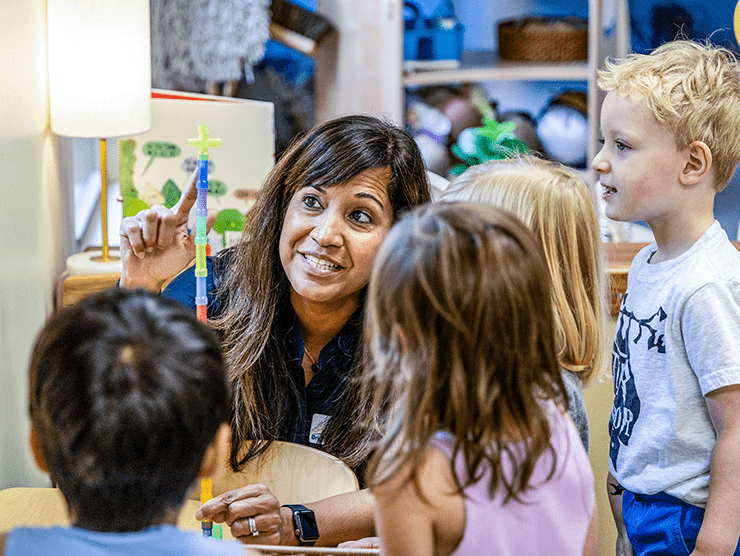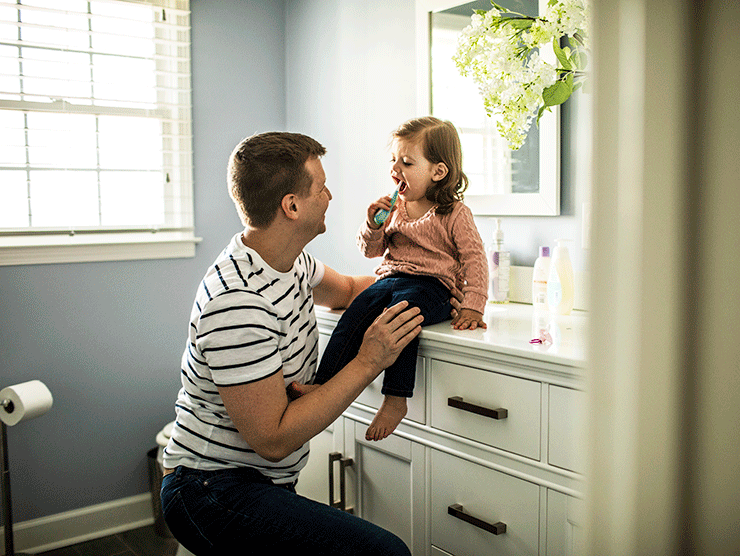Why daycare schedules matter
One of the first major parenting dilemmas is deciding whether to enroll your child in daycare or keep them at home. It’s a decision wrapped in emotion, practicality, and a thousand “what ifs”. While daycare is often a necessity for parents returning to work, it offers more than just convenience. The consistency, social interaction, and thoughtfully structured schedules can play a key role in supporting your child’s development, happiness, and overall well-being.
At Bright Horizons®, daycare schedules are designed to emphasize play, learning, and nurturing care. This guide breaks down what to expect from daycare routines at each age and a look into what Bright Horizons classrooms look like in each age group.
How daycare schedules nurture growth and development
A daycare schedule isn't just about keeping children busy. It’s a routine carefully designed to support early development through structure, consistency, and care. But most importantly, daycare provides a reliable routine that helps children feel safe, confident, and ready to explore the world around them.
A typical daily daycare schedule includes:
- Drop-off and welcome time
- Guided play and activities
- Meals and snacks
- Rest and quiet time
- Outdoor play
- Pick-up
These elements are not just meant to keep children busy throughout the day; they’re strategically planned for physical, emotional, social, and cognitive support.
These carefully designed experiences aim to support every aspect of child development. But just as important as what children do each day is the consistency with which those experiences unfold.
Consistency is important for emotional security. Children naturally feel less anxious when they know what to expect, laying the groundwork for stronger relationships and a greater readiness to learn.
Daycare schedules by age
Infant schedule (0-12 months)
Daycare schedules for infants are designed to be flexible and prioritize each child’s individual feeding and sleeping needs. Rather than following a rigid timetable, teachers respond to the unique rhythms of each infant to ensure comfort and consistency.
In a Bright Horizons infant classroom, teachers engage children in a variety of developmentally appropriate activities that promote and support healthy growth through:
- “Prime Times” which are intentional one-on-one interactions that nurture strong, responsive relationships between adults and children. These moments support children's emotional development, foster secure attachments, and encourage meaningful communication through serve-and-return exchanges.
- Daily exposure to the arts, helping infants explore the world through their senses while supporting cognitive and emotional development. These creative experiences promote peaceful classroom environments, teach scientific concepts, and encourage curiosity through cause-and-effect learning.
- Reading and singing together to nurture a love for books, support early language development, and build vocabulary. These shared experiences also deepen teacher-child bonds and help children explore themselves and others through stories.
- Sign language provides infants with a way to communicate before they can talk, helping reduce frustration and building early language skills. It also strengthens teacher-child connections by showing children that communication can meet their needs.
- Treasure baskets offer calming experiences that engage their senses, helping infants learn about their world through exploration.
- Outdoor time helps children connect with nature while supporting motor and sensory development.
Toddler schedule (1-2 years)
As toddlers grow, their days begin to include activities that support their curiosity, independence, and social development. In a Bright Horizons toddler classroom, teachers may engage children in:
- Building relationships through maximizing prime times.
- Fostering language development through daily reading experiences.
- Daily sensory activities which encourage inquiry, exploration, experimentation, and investigation.
- Small group activities which give children more chances for meaningful conversations and positive social interactions with their peers and teachers.
- Building self-help skills which encourages independence increases self-confidence, and gives children a sense of ownership of their own bodies.
- Exploring cause-and-effect to boost scientific thinking, problem-solving, creativity, and imagination.
- Daily outdoor experiences which give toddlers the opportunity to learn new ways to maneuver their bodies and to aid them in motor and sensory development.
In this age group, toddlers begin to adapt to a set and consistent daily schedule providing a sense of stability and routine. For example, snack and lunch times aim to promote healthy eating habits and social interaction while rest times support healthy growth and emotional regulation.
Preschool schedule (3-5 years)
In the preschool stage, children thrive with a more structured daily routine that supports all areas of development. In the classroom, teachers guide children through a variety of activities designed to build confidence, independence, and school readiness.
A day in a Bright Horizons preschool classroom may include:
- Prime Times for nurturing and building relationships.
- Integrated language experiences such as:
- Journals for drawing, narrating, and early writing
- Dramatic play and storytelling
- Books that reflect children, their families, and their communities
- Daily language and conversation prompts
- Materials that inspire curiosity and exploration
- Morning and Afternoon meetings for children to reflect on learning experiences and share their thoughts.
- A predictable flow to their day using job boards, visual schedules, choice boards, mindfulness activities, and planned transitions with movement and songs.
- STEM experiences which offer interdisciplinary learning opportunities and encourage critical thinking, curiosity, exploration, and inquiry.
- The mirrors and windows approach which creates an inclusive classroom where children can see themselves reflected (mirrors) and get the opportunity to see the world around them (windows). Teachers implement this through:
- Classroom-created books using pictures brought in from families.
- Self-portrait activities to explore the concept of self-identity.
- Daily small and large group activities to share different perspectives and cooperate with others.
- Documentation boards that help children reflect on past learning experiences.
- Regular project work which extends the learning environment and provides an integrated and in-depth study of an idea or concept.
- A healthy balance between indoor and outdoor activities to ensure that children stay active and engaged throughout the day.
With this age group, they begin to practice routines that help prepare them for school through following directions, participating in group activities, and managing personal belongings.
The Bright Horizons Approach
At Bright Horizons, we believe a well-structured daycare schedule lays the foundation for lifelong learning. From infant care to preschool, our programs combine nurturing relationships, play-based learning, and age-appropriate routines to help every child grow with confidence.
Explore our curriculum or find a child care center near you to get started.





